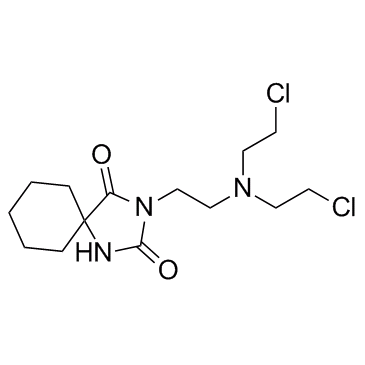| Description |
NCI172112 is a classical bifunctional alkylating agent synthesized in an effort to develop antitumor agents effective against CNS tumors.
|
| Related Catalog |
|
| In Vivo |
NCI172112 (Spirohydantoin mustard, SHM) might serve as a carrier to cross the blood brain barrier[1]. The cumulative excretion of radioactivity in the urine and faeces of rats after administration of [2-chloroethyl-U-14C]NCI172112 or [hydantoin-4-14C]NCI172112 ( 3.13 mg/kg. i.v.) is measured. Four hours after dosing, a significantly (P<0.005) greater amount of radioactivity has been excreted in the urine of rats treated with [hydantoin-14C]NCI172112 than with [ethyl-14C]NCI172112. However, by 24 h, approx.50% of dose is recovered in the urine with both labelled materials. Clearance of radioactivity in the faeces is slow, but, as for the renal excretion, is significantly greater for the hydantoin-14C moiety. No radioactivity is found in the expired air of a rat receiving a single dosing of [hydantoin-14C]NCI172112 and less than 1% is measured after administration of [ethyl-14C]NCI172112. Renal clearance of radioactivity is similar 4 h after administration of [14C]NCI172112 to rats with biliary cannulas, with 14.1±2.9 and 17.5±2.1% of the ethyl-14C and 34.5±2.5 and 33.1±6.3%, of the hydantoin-14C dose appearing in the urine after dosing with 3.13 and 6.25 mg/kg,respectively. A difference in the 4 h urinary excretion of the two labels also is observed in dogs given [14C]NCI172112 (1 mg/kg, i.v.). The percentages of hydantoin-14C and ethyl-14C eliminated are 29.4±2.7% and 17.2±3.5%, respectively (P<0.05)[2].
|
| Animal Admin |
Rats[2] Male Sprague-Dawley rats (190-240 g) are lightly anaesthetized with pentobarbital (30 mg/kg i.p.) and [14C]NCI172112 (2 μCi/rat, 3.13 mg/kg) dissolved in DMSO injected into the femoral vein. The animals are individually housed in glass metabolic cages, with access to food and water for 96 h, and urine and faeces are collected separately. At 96 h, the rats are killed with an overdose of pentobarbital and each carcass is homogenized in 4 vol. water with a Waring blender. Radioactivity in aliquots of drug soln. and urine are measured by liquid scintillation counting with 15 mL phosphor. Dogs[2] Female foxhounds, weighing 15-20 kg, are anaesthetized with pentobarbital (30 mg/kg) and are maintained in this state throughout the experiment with aditional pentobarbital. [14C] NCI172112 (50-60 μCi, 1 mg/kg) in 1 mL DMSO is administered to the dogs via a catheter inserted into the femoral vein. Blood samples are withdrawn from the femoral artery by means of an indwelling catheter at timed intervals from 1 min to 4 h and transferred to heparinized tubes chilled on crushed ice. Immediately, a 0.5 mL aliquot is removed and extracted with three 2 mL vol. of cold toluene. The remaining blood is centrifuged, and 0.5 mL aliquots of plasma digested with NCS, extracted with 2 mL vol. of toluene or diluted with 2 mL 10% trichloroacetic acid. From the initial sampling of the dog blood to the start of the extraction or pptn. procedures for plasma, 8-14 min elapsed.
|
| References |
[1]. Brown TD, et al. A phase I trial of spirohydantoin mustard (NSC 172112) in patients with advanced cancer. J Clin Oncol. 1986 Aug;4(8):1270-6. [2]. Plowman J, et al. The disposition of spirohydantoin mustard (NSC 172112) in rats and dogs. Xenobiotica. 1979 Jun;9(6):379-91.
|


